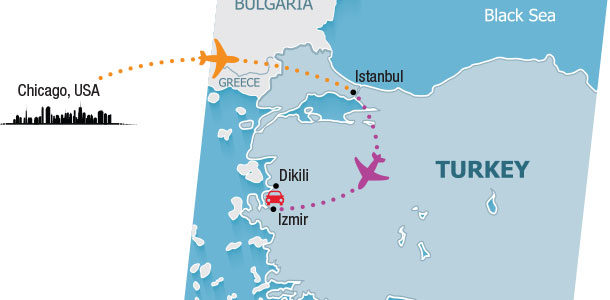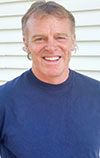While volunteering at the Hoof Trimmers Association booth at World Dairy Expo, I had the pleasure of meeting Dr. Oguz Calisici, a veterinarian from the country of Turkey and the general manager of a large dairy farm.
He asked me if I would be interested in going to Turkey to trim and to teach his trimmers some new techniques. Over the next several months, we kept communicating ideas and schedules, and finalized plans for a trip earlier this year.
After talking with some of my regular trimming customers and researching dairy farming in Turkey, I learned that the country, which is located between western Asia and southeastern Europe, has an ever-increasing dairy industry. Over the past several years, Turkey has been importing U.S. Holstein dairy cattle as the people are acquiring a growing taste for dairy products, particularly yogurts.
Dr. Oguz prepared me by sending pictures of his trimming equipment and supplies, and I packed all I thought I needed. I was looking forward to this mid-January trip, knowing it would provide a great adventure as well as a small reprieve from our brutal Wisconsin cold, with 50 to 55ºF being the average daily high in Dikili, Turkey.
My journey began with a 10-hour flight from Chicago to Istanbul. I had a brief layover and transfer to Izmir, followed by a two-hour car ride to Dikili. The car ride was interesting, as the driver spoke no English and it was already dark.
Day one
After a restless night, I awoke excited to start my first official day trimming in Turkey. My hotel accommodations at the Perla Otel included breakfast with an assortment of cheeses, cold cuts, bread and two types of olives. After breakfast, I had coffee on an outdoor patio overlooking the Aegean Sea as I waited for my ride to the farm. I finally saw my first familiar face in Turkey, that of Dr. Oguz, who picked me up and drove me to the farm 15 minutes from Dikili.
We arrived at the farm, “Süt Kardeşler,” which translates to “Milk Brothers” in English. Süt Kardeşler is a dairy owned by a parent company that has multiple ventures including greenhouses, sheep and beef farms. The parent company recruited Dr. Oguz to start the dairy two years ago, and since its inception, it has grown to 1,400 cows.
There is a full-time hoof trimmer on-site. He had been able to keep up with the dairy’s trimming demands at a rate of about 10 cows per day, but with plans to double the herd size, he would fall behind at that pace. My charge was to evaluate trimming practices and provide guidance to increase speed and efficiency in order to keep up with the dairy’s anticipated demand.
Around 11 a.m., I finally entered my zone: the hoof trimming facility. I met their trimmer, Satilmis, and his helper, Jimmy, and observed their work. Right away, I could tell they were compassionate, and from what I could see, they were doing a good job trimming. I also know from working with other trimmers not to be too critical. I did not want to start telling them what they were doing wrong. My goal was to reinforce all the positives and encourage them to try some newer techniques.
As I observed the trimmers putting the next cow into the chute, I noticed how hard they had to push and encourage her to get in. I mentioned this to Dr. Oguz and told him how much easier cows would go into the chute if they used a small gate. I explained the dimensions of the one I use. He made a quick phone call, and then we went to lunch in the dairy’s cafeteria.
On any given shift, there may be 20 or more employees or visitors. I am not sure of the degree of involvement, but the government subsidizes the dairy industry and there is money to hire many people. The cafeteria reminded me of a chow hall back in my army days, walking through the line with a metal tray with sections while the mess sergeant spooned food on your tray.
After a leisurely lunch, we returned to the trimming barn and lo and behold, a brand-new gate was there with the dimensions I had just given to Dr. Oguz. His phone call before lunch was to the farm’s maintenance chief, who made and delivered it during our lunch break. I then stayed and trimmed with Satilmis and Jimmy the rest of the day.

My first suggestion and demonstration was the use of the gate. After a couple of cows, they could see its value. The cows moved so much more easily, making a difference in cow flow efficiency of four to five more cows per day. My next suggestion was not to tie down the cows’ heads. This was only going to save one to two minutes per cow; this change alone could increase efficiency by one cow per day.
The trimmers were also washing the cows’ feet before trimming using a water hose and brush. I suggested they eliminate this step, too. The hooves do not need to be that clean prior to trimming; additionally, if lesions become saturated with water, topical treatments are less effective. I showed them how using a dull knife to scrape off the hoof was good enough. The workstation stayed drier, it saved time, and the hoof-trimming surface was still visible.
I also observed how the cows were backing up as they exited the chute. At the end of the day, Dr. Oguz returned, and I explained to him how a drop bar placed behind the cows would prevent them from backing up. He called his maintenance chief, who came to the trimming shed. I tried to explain to him by sign language and Dr. Oguz’s interpretation.
By the end of day one, we had trimmed 19 cows. From what I saw, hoof issues in Turkey are similar to those in the U.S. I observed some hairy warts, which in Turkey and other parts of Europe are identified as Mortellaro’s disease, named for the first researcher who identified the condition. I also observed a couple white-line abscesses and ulcers.
Day two
Day two started with another great breakfast, complete with olives, of which I learned Turkey is a leading producer. Dr. Oguz gave me a tour of the greenhouses owned by the parent company, Baltech. The greenhouse facility was one of the largest in Europe with more than 150 acres under cover. Quite impressive … but I finally got back to trimming by 11 a.m.
Just as I had suggested the previous day, there was now a drop bar welded to the chute to prevent cows from backing up, and it worked wonderfully. We continued to practice using the gate and back-up bar. Satilmis tried using the grinding wheel I brought along. I also brought my roto clip wheel, which I put on one of their grinders. I had to use one of their grinders, as mine did not work on the European 240-volt system.
He liked using mine, as it was more aggressive than his was. I tried telling him to change his blades, but he thought they were OK. The grinder I put on my wheel was a finishing rasp. I convinced them rasping after trimming was not needed. Several years ago, many trimmers in the U.S. rasped hooves after trimming, as it gives them a polished look, yet it adds nothing to the function of the hoof. By the end of the day, we had trimmed 27 cows.
That evening, the farm crew treated me to a great dinner at a local restaurant. I experienced squid, crab, octopus and Turkish beer. Although not the last night, it was my farewell dinner as Dr. Oguz was heading out of town the following day for a meeting in Ankara.
Day three
On my final day, it was olives for breakfast again, then right to the farm for trimming by 9 a.m. We started right away with trimming maintenance cows, then we re-checked some of the cows that were in a sick cow area. We also trimmed several heifers. We stopped a few times so I could offer pointers on how I would trim differently, being careful not to criticize.
After our lunch break, I had Satilmis change blades, even though he still thought his were fine. Once changed, he could hardly believe the difference. He was so used to the dull blades that he must have thought that was the norm. His wheel was now almost as aggressive as mine was. By the end of the day, we had trimmed 35 cows.
Now, a few months since my trip to Turkey, I continue to follow up with the farm. Satilmis is trimming 15 cows per day. However, more importantly, it doesn’t take him all day to do that number and he is able to do other tasks on the farm with his spare time.
I had a great trip and got to meet several wonderful people. I am glad to have befriended Dr. Oguz; he is one of the smartest people I have ever met and is fluent in English, German and Turkish languages. I hope to return to see progress in trimming and reconnect again with my new-found friends. PD
Skip Blake is with Shamrock Cow Care. He can be contacted by email.
See more photos of his trip. View the slideshow.
PHOTO:Hooftrimmer Skip Blake traveled from the Midwest to the Middle East to teach his technique on a1,400-cow dairy. Photo by Julie Vasquez.






